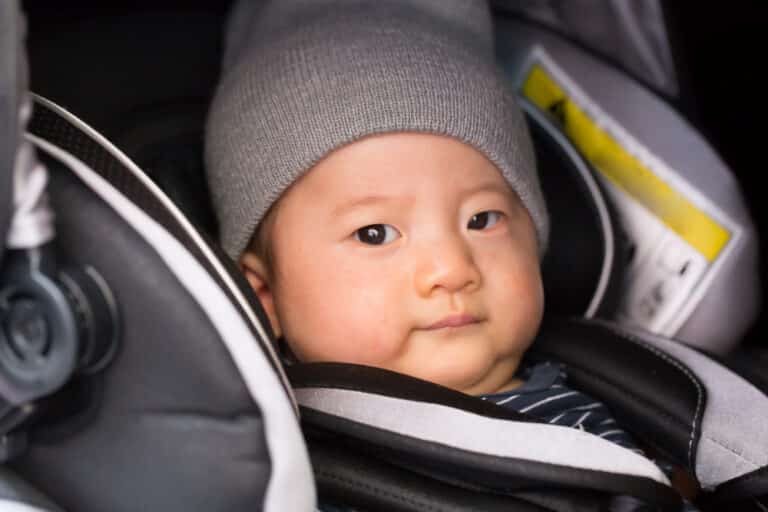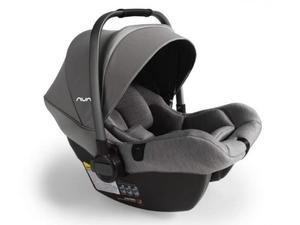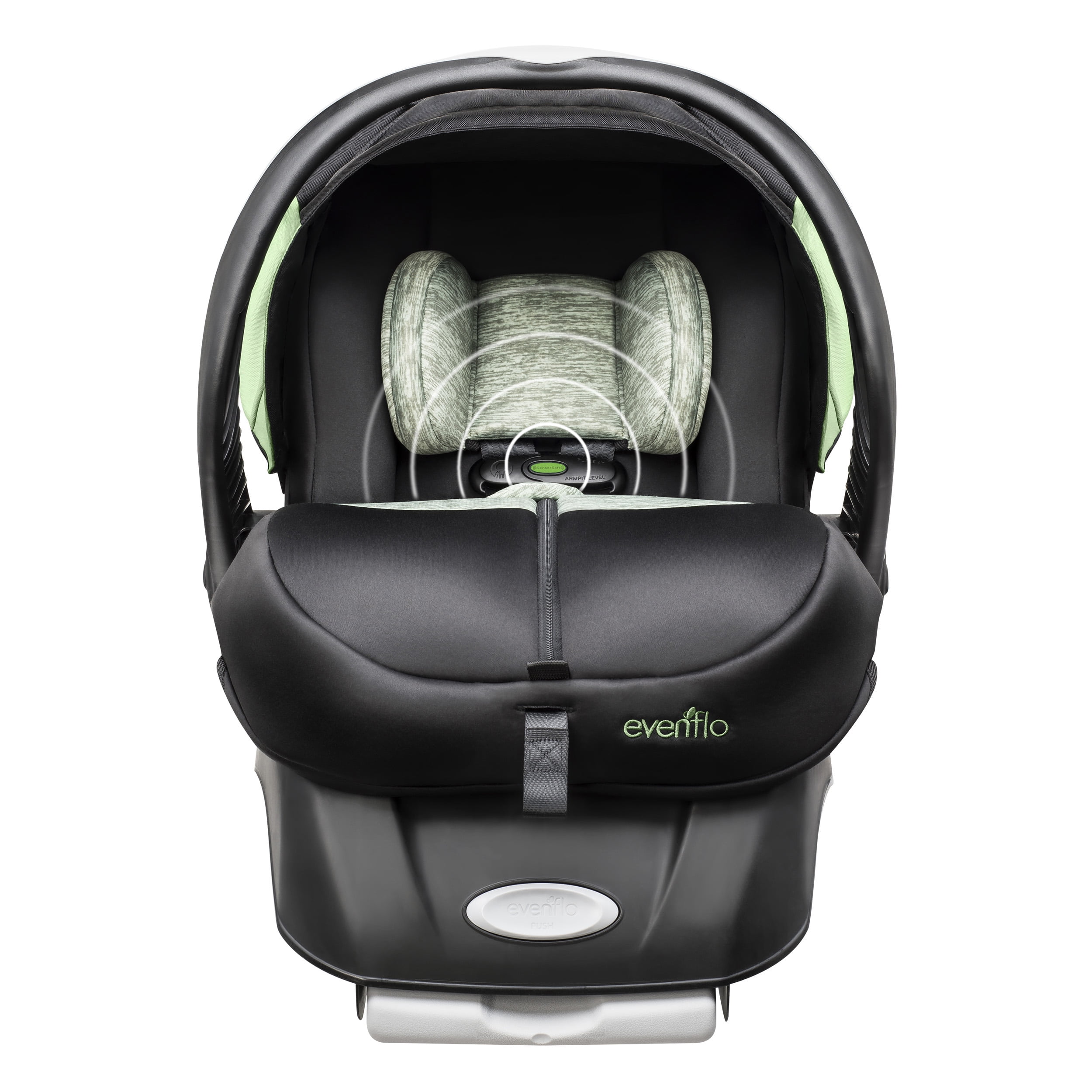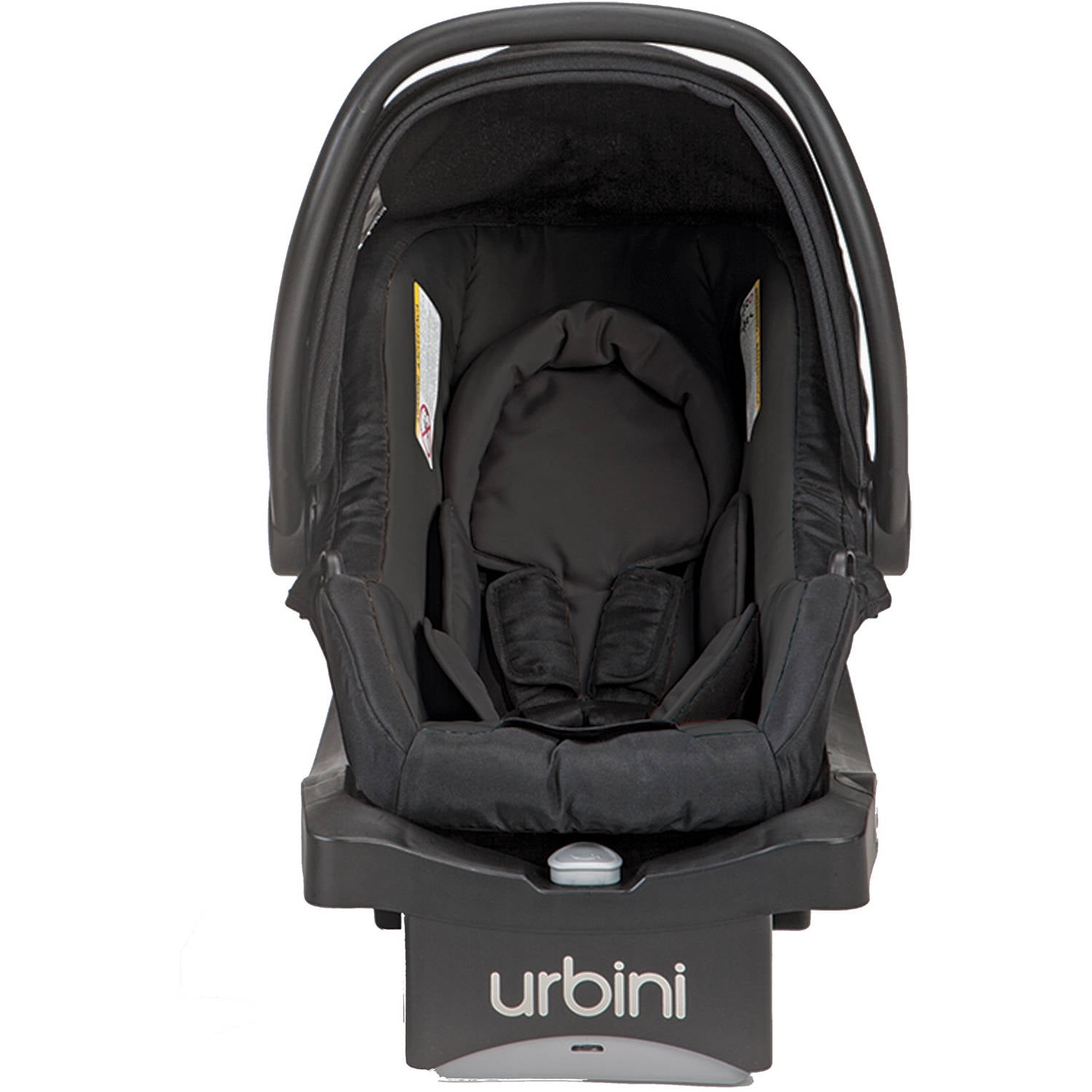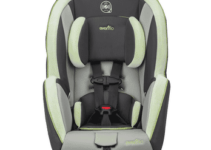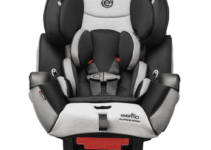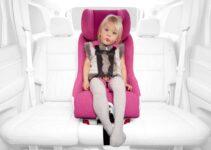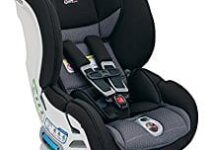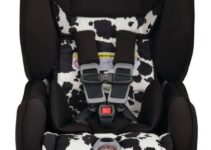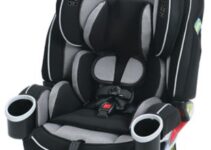Shopping for a new baby is a strange mix of bliss and stress. Stocking up on unimaginably wee socks and nightgowns? Fun! Buying your baby’s first car seat? Very much not so.
There are hundreds of car seats on the market, and they all look pretty much the same. You can spend $40 or $500. If you spend more, will your child be safer? Does every seat fit in every car? Just how are you supposed to choose?
I’ll let you in on a little secret: even as a children’s product expert and certified Child Passenger Safety Technician with many years of experience helping parents choose and use car seats, I find car seats confusing, too.
There are so many brands! And types! And rules! And it changes all the time too 🙁
But though buying a car seat is complex, it’s not impossible. I’ve pulled together all the basics right here, so you have all the information you need to ensure that your child has the safest and most comfortable car seat on the market.
Table of Contents
- How Do We Rate Car Seats?
- Our Top Picks for the 7 Best Infant Car Seats
- #1. Chicco KeyFit (Best all around)
- #2. Graco SnugRide (Best value for your money)
- #3. Britax B-Safe 35 Ultra (Top comfort and safety)
- #4. Nuna Pipa Lite (Best luxury pick)
- #5. Evenflo Advanced Embrace DLX with SensorSafe (Best for safety)
- #6. Urbini Sonti (Best value for your money)
- #7. Maxi-Cosi Mico Max 30 (Best Designer Look)
- How to Choose the Right Infant Seat for Your Child
If you’re just here for car seat recommendations, here you go. These are the very best infant car seats you can buy.
How Do We Rate Car Seats?
How do we go about deciding the best car seats on the market? We use a set of 5 criteria:
1. Value: we look at the car seat’s overall features, and compare that to the price of the seat – the more expensive the car seat is, the more we expect from it.
2. Features: we look at any extra value-added features on each seat, and compare them to the features offered in other seats.
3. Customer experience: We examine customer ratings on many platforms to see what users think about each seat, and how positive or negative their experience is.
4. Problems: We look at what problems consumers report, the severity of these problems, and how difficult or easy they find the seat to use.
5. Durability: We consider how durable and long-lasting each seat is: How long will it safely hold a child? How soon does the seat expire?
Using these criteria, we examined dozens of car seats currently on the market to pull together this best-of list of 7.
Bottom line: these seats are safe, easy to use, and beloved by parents. They generally provide a good fit for infants and in most vehicles. If you want to try before you buy, there are still some specialty baby retailers left in many towns that will let you try out a couple of car seat models in your car, and they may even have an employee who can help.
Our Top Picks for the 7 Best Infant Car Seats
#1. Chicco KeyFit (Best all around)
4 – 30 lbs., up to 30 inches
The KeyFit costs more than the our #2 pick – the SnugRide – but if you can afford the extra cash, the KeyFit will make you happy you spent more. The fabrics and padding are a notch nicer than what you’ll find on the SnugRide, and everything in general is just a shade easier to use: the seat’s easier to install, buckles work smoothly, the seat has a built-in lockoff for your car’s seat belt so if you use the belt to install, you don’t have to monkey with your seat belt’s locking system.
The good: Great features like a bubble leveling system that makes it easy to see if you’re installing at the right angle, easier-to-use buckles, and a latch-tightening lever that works very well.
The not so good: This seat is on the more expensive side.
The best part: If you buy the Zip version of the seat, the cover easily zips off, can be thrown in the washer, and then zips back on.
Is it for you? If you can pay a little extra, the KeyFit’s premium features will make you happy you did.
Click here to see today's price for the Chicco Keyfit on Amazon#2. Graco SnugRide (Best value for your money)
4 – 30 or 35 lbs. and up to 30 or 32 inches
Arguably the best-selling infant car seat on the market (duking it out for supremacy with the Chicco Keyfit), the Graco SnugRide is a good, solid, safe seat with surprisingly cushy padding for the price. The SnugRide comes in many variations: the SnugRide 30 (with a weight maximum of 30 pounds), the SnugRide 35 (maximum weight 35 pounds), the Graco SnugRide Snuglock (has a gadget that makes it easier to install the seat with a seat belt instead of LATCH), the Graco SnugRide Click Connect (compatible with Graco Click Connect strollers). They’re all good seats, so you may want to buy whatever’s on sale at the store you visit.
The good: For a moderate price, the SnugRide is easy to install, comfortable, fits well in most vehicles, and is easy to use.
The not so good: Graco’s harness buttons aren’t as easy to use as on other brands, an everyday hassle that can be a real drag. In addition, the seat lacks ease-of-use features like those found on other seats.
The best part: Weighing in at 7 pounds, this car seat is on the lighter side and easier to carry.
Is it for you? If you’re looking for the best-all-around seat at a moderate price, this seat is your pal.
Click here to see today's price for the Graco SnugRide on Amazon#3. Britax B-Safe 35 Ultra (Top comfort and safety)
4 – 35 lbs., up to 32 inches
Britax is known for going above and beyond in safety testing its seats – though all car seats on the market have to pass minimum safety standards, Britax’s seats pass even more stringent side impact tests. It’s generally even more expensive than the KeyFit, and it feels that way: this seat is premium in every way, with very easy to use LATCH connectors, a built-in seatbelt lockoff, a very comfortable carrying handle, and other upscale features.
Pros: Britax is known for its extraordinarily easy-to-use harness buckles – they release easily and fasten with a reassuring click. This car seat is on the narrow side, so it’s easier to install in tighter back seats.
Cons: Like the Keyfit, this seat is more expensive than many comparable seats.
The best part: In general, the B-Safe is higher quality than many other brands: nicer fabrics, better hardware.
Is it for you? The B-Safe isn’t accepted by as many strollers as the KeyFit or the SnugRide, so if you plan to install the seat and leave it in the car or to use a Britax stroller, this is your seat – if you can afford the price.
Click here to see today's price for the Britax B-Safe 35 Ultra on Amazon#4. Nuna Pipa Lite (Best luxury pick)
It costs about three times as much as the SnugRide, and nearly twice as much as the KeyFit or the B-Safe. But the Nuna PIPA lite makes parents who shell out for it happy they did. Unlike almost every other car seat on the market, the PIPA lite contains no added fire retardant chemicals – and if you choose the (more expensive) Nuna PIPA lite LX, the seat cover is made of premium merino wool, which feels great to the skin, keeps winter babies cozy, and doesn’t make summertime babies sweat.
The good: In every way, this seat is top of the line. Constructed of aerospace aluminum, it weighs in as the lightest seat on the market: 5.3 pounds, which makes your baby easier to carry around. It’s amazingly easy to install, narrow, has beautiful fabrics.
The not so good: The Nuna PIPA lite is the most expensive seat on this list.
The best part: The PIPA has perhaps the best canopy on the market: the huge shade offers UPF 50 sun protection, can be removed if not needed, and operates silently and smoothly, so it won’t wake any sleeping babies. It also has a fold-out eye shade that ably blocks the late afternoon sun.
Is it for you? If you can afford it, this seat is an absolute dream to use, even in small cars.
Click here to see today's price for the Nuna Pipa Lite on Amazon#5. Evenflo Advanced Embrace DLX with SensorSafe (Best for safety)
4 – 35 lbs., 17 – 30 inches
Evenflo is a car seat brand that doesn’t get as much attention as others, but the company makes wonderful car seats that are typically less expensive than comparable seats. We love this seat’s premium stapler-style lower anchor LATCH connectors, which are much easier to use than the cheap hooks in some seats, and the seat comes with a foot muff that’s handy if you’re using the seat in cold months.
But the marquee feature here is SensorSafe, a little gadget that you plug into a port on your vehicle that communicates with your seat’s chest clip. When you turn off the car, it sounds a tone to remind you that your infant is in the seat to prevent accidental hot-car deaths. It also chimes if your baby unbuckles the chest clip.
The good: Evenflo is known for being a value brand with seats that work very well, comparable to Graco seats but generally less expensive.
The not so good: This seat doesn’t have the high-end features of more expensive brands, like latch tightening gadgets or a bubble leveler.
The best part: SensorSafe is one of very the few easy-to-use systems on the market that lets you know if you’ve left your baby in the car – and if you have an escape artist on your hand, the warning signal for unbuckling is absolutely priceless.
Is it for you? If having a technological safeguard against forgetting your baby in the car sounds reassuring, this seat is a good choice.
Click here to check today’s price for the Evenflo Advanced Embrace DLX at Walmart
#6. Urbini Sonti (Best value for your money)
4 – 35 lbs., up to 32 inches
Urbini is a relatively new brand that doesn’t get a lot of attention. But its car seats and strollers have a lot of style for the price, and are relatively easy to use (though no one will mistake this for a high-end seat). The Sonti is the least expensive car seat on this list, yet it’s passed the same safety tests as every other seat. For parents who need a second seat for a second car, or a seat for short trips around town, the Sonti works very well.
The good: The Sonti offers an impressive weight/height range for the price.
The not so good: It’s pretty basic, and not the easiest seat to install. It’s also not as padded or comfy as other seats, so children may complain on long car rides.
The best part: The Sonti is also super-narrow: less than 16 inches at the base, which makes it easier to install 3-in-a-row seats, or in smaller back seats.
Is it for you? If you’re not going on lots of long road trips and want a bargain option, the Sonti is a great choice. If you’re having multiples, you may appreciate how easy it is to install more than one Sonti in the back seat.
Click here to check today’s price for the Urbini Sonti at Walmart
#7. Maxi-Cosi Mico Max 30 (Best Designer Look)

4-30 pounds, up to 32 inches
Maxi-Cosi is a European brand that’s less well-known on this side of the pond. But though Maxi-Cosi fans are fewer in number, they’re extremely passionate about their favorite car seat brand, because Maxi-Cosi makes breathtakingly beautiful seats.
The brand is known for collaborating with designers like Rachel Zoe and Edward van Vliet to make seats with premium details like sweater-knit or signature designer fabrics, leather accents, bright colors that put basic black seats to shame.
The good: For not much more than bargain brands, Maxi-Cosi’s seats are plush and comfy, with expanded safety features like a rebound bar on the base that minimizes movement in the event of a crash and easy-to-operate LATCH connectors. The Mico Max 30 also gives a great fit for smaller babies, with a top-of-the-line infant insert.
The bad: With a weight limit of 30 pounds, bigger babies might outgrow this seat too quickly.
The best part: Seat covers are a snap to remove, and can go right in the washing machine and dryer, a real rarity for car seats.
Is it for you? If you want an absolutely gorgeous seat at a moderate price, look no further than the Mico Max 30.
Click here to see today's price for the Mico Max 30 on AmazonHow to Choose the Right Infant Seat for Your Child
Parents often want to cut through all the car seat noise by asking one question: what’s the best car seat? The answer isn’t quite as simple. The best car seat for your child is the one that:
1. Fits your child
2. Fits your vehicle
3. Can be used properly every time.

So there’s not just one answer for everyone. But picking out the right seat for your family isn’t impossible. Read on, and you’ll learn how to do it just right.
First: Fitting Your Child
Every car seat has a minimum and maximum height and weight for riders. The car seat has been safety tested at these minimums and maximums.
Since you’re probably buying this seat for a not-yet-born child, you may have to do a little guesswork. In the U.S., average newborn weight is 7 ½ pounds; you can expect your baby to be about that size, unless you’re having multiples or have other special circumstances.
Most infant seats fit a child of 5-30 or 35 pounds and 30 inches; if you expect a smaller baby, you might want to get a seat with a weight recommendation that starts at 4 pounds. On the other hand, if you expect a bigger baby, some seats have weight maximums of 35 to even 40 pounds (and are usually more expensive), and height maximums of up to 32 inches
This page has a good chart that shows the weight/height ranges of all the infant car seats on the market. You can also plug weight and height into the National Highway Traffic Safety Administration (NHTSA) car seat finder to get a list of seats that will fit, along with information on the weight/height ranges.
If you have your eye on a particular car seat, you can find out the weight/height ranges online, on the box the seat comes in, or on labels affixed to the seat’s side that look like this.
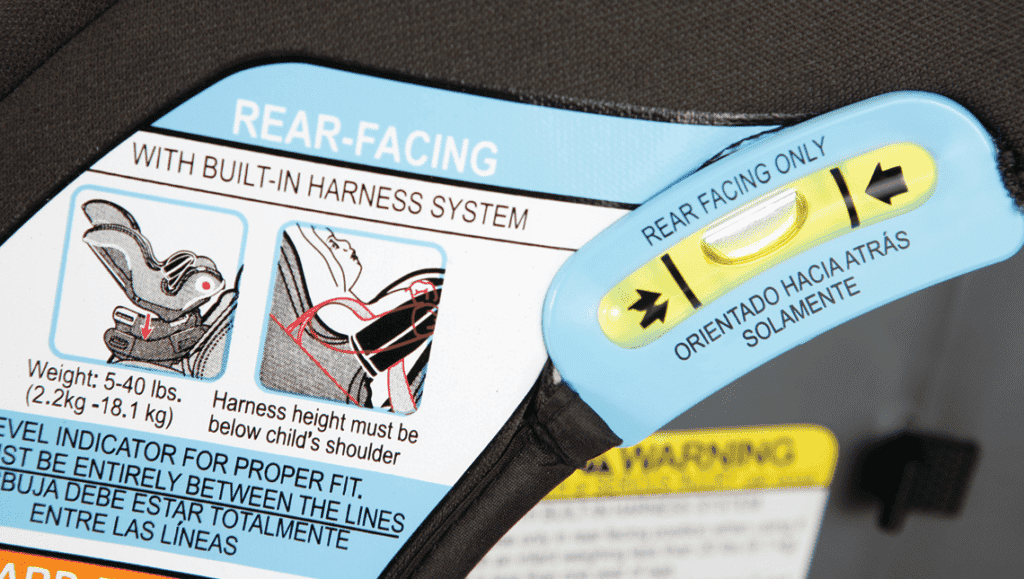
Infants should ride rear-facing, as this NHTSA graphic shows:
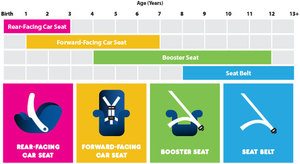
It’s illegal in many states for children to ride forward-facing before age 2. It’s also safer: Children riding rear-facing are from 4 to 5 times safer in the event of a collision.
If you need more convincing, this video shows what a collision looks like when a child is rear-facing vs. forward-facing.

Next: The Ins and Outs of Harnesses
The seat you choose should also fit your child’s body. When babies are rear-facing, harness straps should come out of the seat’s back at or just below your child’s shoulders. The fit looks like this.
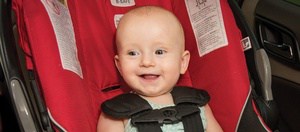
Why? Because it’s the harness’ job to hold the child in the seat, and if shoulder straps are too high, the child will slide up the seat’s back rest in a crash. This subjects the head and body to unnecessarily high forces. Having the straps above the shoulders can be just as dangerous as the harness being too loose.
If the harness straps are above your child’s shoulders even when they’re routed through the lowest slot, you should choose another seat.
The last key part of a car seat fitting your child correctly: The seat’s harness should fit your child tightly. Many seats come with infant pillows that help babies fit more comfortably in a seat. Don’t buy or use infant pillows that don’t come with your seat – they haven’t been tested and may not be safe.
Finally: The Fit in Your Vehicle
Finally, the seat should fit well in your vehicle. We’ll explain how to check for a good fit in a few paragraphs. Here we’ll just say that if you can’t get a good fit in your vehicle using LATCH or your seat belt, you should choose another seat.
To make this process easier, shopping for seats at a store that will let you try them out in your car is a good idea. Your best best is a specialty baby store – many have seats to try, and even employees who can be helpful in the parking lot. Large retailers like Target, Walmart, and Macy’s have a limited range of seats in stores.
Many online retailers offer free shipping on car seats too, to make trying-and-returning an easier process. Wherever you buy, make sure it’s from a retailer that offers returns.
Why Use an Infant Car Seat?
Simply put, using a car seat keeps your child safer in the event of a collision. Using a car seat reduces the risk for death to infants (1 year or less) in passenger vehicles by 71 percent.
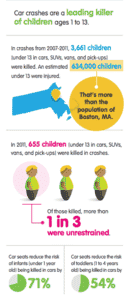
This is what a crash looks like when a child is unrestrained.

Okay, you’re sold on the idea of using a car seat at all, but infants can be safely restrained in infant car seats, convertible car seats, or all-in-one car seats. What’s the difference?
Infant car seats look like this. This is a picture of the Graco SnugRide.
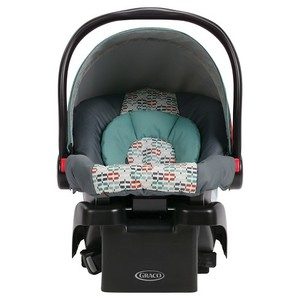
Infant car seats have a base that’s installed in the car and a carrier that clicks in and out and can be used inside or outside the car and carried with a handle. It’s used for an infant of 1 year or less.
A convertible car seat looks like this Chicco Nextfit:
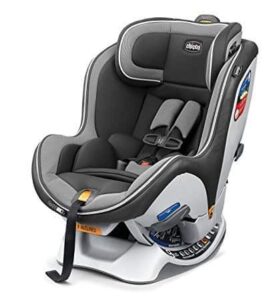
It doesn’t come apart and it’s not used as a carrier. But it can converts (thus the name) from rear-facing or forward-facing as your child grows and is old enough to forward-face.
Finally, the third type, an all-in-one car seat looks something like this Graco 4Ever:
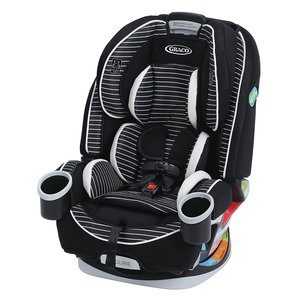
Kinda looks like the convertible, huh? Like convertible seats, all-in-one car seats aren’t used as a carrier, and can be used forward- or rear-facing. Unlike convertibles, they also transform into a booster seat for older kids that uses your car’s seatbelts instead of the five-point harness you see above with the red button.
Which should you choose? Most experts advise that parents choose an infant seat for newborns, because:
• The carrier makes it easier to take your infant in and out of the car and other places (in the stroller, in the house) without having to wake the baby by taking them out of the seat. This is particularly useful and convenient when a baby is small.
• Many infant seats include special infant seat pads/pillows that can give a better fit than some convertible seats.
• The straps and harnesses on infant seats often fit infants better.
• Newborns must ride at an angle between 30 and 45 degrees in order to not restrict breathing – this angle is often easier to get correct using an infant car seat rather than a convertible.
• The “bucket” of newborn seats can often be used without the base in a taxi or another car to save hassle of uninstalling and reinstalling the seat.
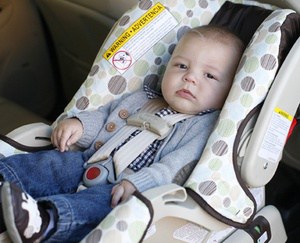
However, getting an infant seat instead of a convertible or all-in-one means that you’ll buy more seats over your child’s lifetime. This may or may not be more expensive, depending on what seats you choose.
If you use an infant seat, also have to buy another car seat when your child is one year old or if they outgrow the seat’s weight or height limits during that year. This is twice the hassle of just buying a single seat, so take that into consideration when making your choice.
How to Install an Infant Car Seat
Once you’ve zeroed in on the right car seat for your needs, your child, and your budget, the only way to figure out if that seat also fits properly within your car is to install it. Where and how?
As we showed you above, infants should ride rear-facing. So you’ll be installing your seat rear-facing, whether you chose a convertible or an infant car seat.
You should also install your car seat in your vehicle’s back seat. It’s safest for every rider. Rear-facing car seats in particular should never be installed in the front seat of a car that has airbags as the bag can forcibly deploy and crush your infant between the car seat and the front of your passenger seat, as this video shows.

If you must install a child safety seat in the front seat of a vehicle, you should turn off air bags, and push the passenger seat as far back as possible. But it’s still not as safe as installing a car seat in the rear of a vehicle.
Where In the Back Seat?
The safest place of all in the car is the middle of the back seat. If you can install your car seat in the middle, that’s the best choice.
However, the middle seat in some cars is narrow, uneven or otherwise doesn’t provide a good fit. If that’s the case in your car, installing the car seat on either outboard side on the back seat is fine.
Something that may help you make your decision: most vehicles don’t have LATCH lower anchors for the center seat.
Should You Install Your Car Seat with LATCH or a Seat Belt?
Short answer: You should use the one that gives the best fit, but not both.
What is LATCH? LATCH stands for Lower Attachments and Tethers for Children and it’s a way of connecting your car seat directly to the car’s frame. Rear- or forward-facing car seats can be installed using your car’s seat belts or LATCH.
LATCH lower anchors can be found in the bight, or crack, between your seat’s back and the portion that goes underneath you when you sit. You may have to feel for them in the bight, they don’t stick out on every car. They look something like this:
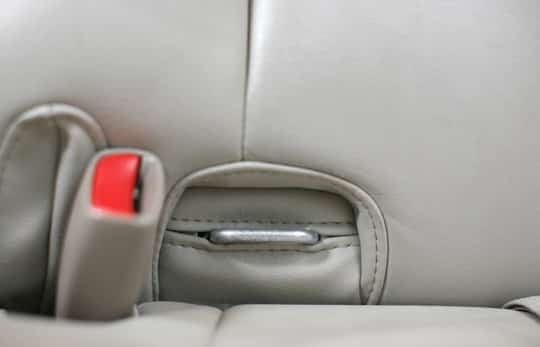
A piece of hardware that looks something like a stapler, or, on some seats, a hook, is attached to your car seat. It looks something like this.
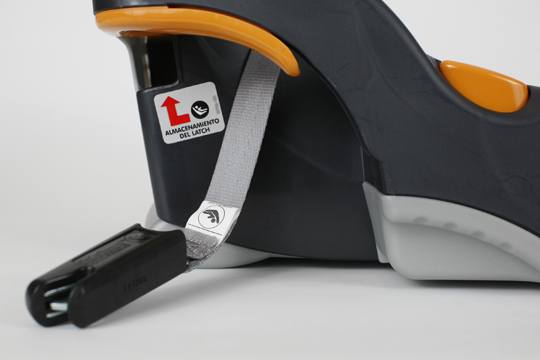
Basically, to install your seat rear-facing using LATCH, you connect the lower anchor connectors to the lower anchor inside your car, like this.

We’ll show you in a few paragraphs how to install your car seat using LATCH. But for now, you should know that if you want to use LATCH, it may not be possible to install your car seat in the middle of the back seat, since most vehicles only have lower anchors in the outboard back seats.
Borrowing Anchors, or Not?
Some car seat manufacturers allow you to “borrow” anchors from the side seats to install the car seat in the middle of the back seat. But most don’t. You can find out if your car seat maker allows anchor borrowing by reading your car seat manual.
You must also read the Child Passenger Safety sections of your vehicle’s manual to make sure it allows LATCH anchor borrowing. If either manual doesn’t allow borrowing or doesn’t mention borrowing, you can assume that you can’t borrow anchors and should use your car’s seat belts to install the seat in the middle instead, or install the seat in one of the outboard seats using LATCH or your car’s seat belt.
Installing Your Base with a Seat Belt
Installing an infant car seat base with a seat belt looks like this:
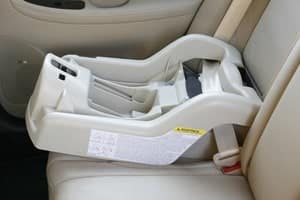
Parents often want to know what’s safest: LATCH or seat belts? The answer is neither. Both are safe. The best installation method is one that provides a good fit in your car. Both may provide a good fit, or neither.
That said, many parents find using LATCH easier. So if you’re installing your car seat in a place in your car where it’s possible to use LATCH, you may want to try that first, and then give seat belt installation a try if LATCH doesn’t give a good fit.
What’s a good fit? This video shows how to install an infant car seat using LATCH or a seat belt and getting a good fit.

How to Install Your Seat with LATCH
Basically, when installing your car seat with LATCH, park on a level area. Then put the seat’s base on your car seat, and make sure that it’s at the right angle. Some seats have a line on their sides that you have to make sure is parallel with the ground, others have an angle indicator that looks something like this:

or like this
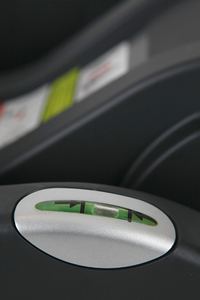
The angle is important, because infants who are too upright can slide down in their car seats and their breathing can become restricted. But if you install the base at the proper angle of recline, you don’t need to worry about this.
Some car seat bases have a foot that drops out of the seat’s base and can help you get the right level. Others instruct users to use a tightly rolled towel or pool noodle to prop up the seat to the correct angle. Parents worry that the pool noodle method isn’t safe – but rest assured, if your manual says you can use a towel or noodle to get a good angle, it’s been tested and it’s safe.
Once you get that correct angle, connect the car seat base’s attached connectors to the anchors in your car, and pull the slack out of the LATCH straps to tighten while putting some weight in the seat by pushing down.
Then check for tightness as the video shows, by grabbing the car seat with your non-dominant hand at the belt path and tugging side-to-side and front-to-back with the force of a firm handshake. A properly installed seat should move less than one inch front-to-back and side-to-side.
Here’s a video that quickly shows how to check for a tight installation:

How to Install Your Seat with a Seat Belt
When you install using your car’s seat belt, you first get the proper angle as described above. Then you need to think about how you will lock your seat belt. When we sit in the back seat and use the seat belt, it remains unlocked until someone in the front seat slams on the breaks. But that doesn’t work with car seats, so if you’re using the seat belt to install your car seat, you have to lock it into place.
There are two ways to lock your seat belt. If your seat comes with a built in lockoff, as seats like the Chicco Keyfit do, you will be using that. If not, you can check to see if your seat belt itself is lockable.
Try pulling your seat belt slowly all the way out to the end. Then let just a little bit of the slack back. Do you hear a ratcheting sound? Can you not pull the belt out further? If so, your seat belt can be locked, and you should pull it all slowly all the way out before you thread the belt through your car seat’s base, to be sure that when you release the tension the seat belt will lock into place and not loosen.
This video shows you how to lock your car seat and what it sounds like when it locks:

Next, after you have locked the seat belt or decided to use the seat’s built in lockoff (which you use after getting the seat buckled), thread the belt through the belt path, buckle the belt, and remove the slack from the shoulder part of the belt while pushing down on the seat. Then check for tightness.
If your seat has a built-in lockoff, your final step is threading that belt through the lockoff. If your seat belt locks after being pulled out all the way, you won’t take this final step.
If you’re using a seat belt to install your car seat, don’t use both a built-in lockoff and lock your vehicle’s seat belt by pulling it all the way out – either one is safe, both together are not.
Some older vehicles don’t have seat belts that lock. In this situation, a seat that comes with a built-in lock is best, or you can order a piece of hardware known as a locking clip from your car seat maker. Professional car seat installers often have them around to give out for free, too. This is what Graco’s locking clip looks like:
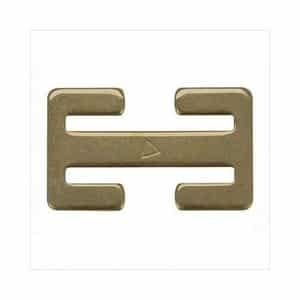
But only older cars and car seats will need a locking clip, so you may not need one at all.
Harnessing Your Child in the Seat and Using it Safely
So at this point, if all has gone well, you’ve got the right seat and a good installation. The nurses at the hospital still won’t let you take your infant home unless they’re properly harnessed in the seat inside the car.
This is what a properly harnessed infant looks like.
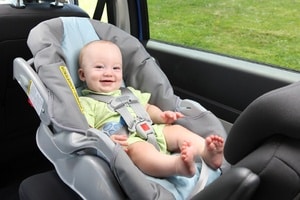
As you can see:
• The harness comes out of the seat’s back at or below this rear-facing infant’s shoulders.
• The chest clip is at the infant’s armpits.
• The child is at a reclined angle: 30 to 45 degrees is the recommended angle, and your seat’s angle indicators will show you when you have the right angle.
• The harness is tight, not loose.
That last one is a little subtle to see on a picture, but if you ever see an infant with harness straps that are buckling, bending, folding, or warping, you’ll know they’re too loose.
Professional car seat installers check that a child’s car seat harness is tight enough by using the “pinch test”: when pinched vertically at a child’s shoulder, you shouldn’t be able to pinch up any slack.
Here’s a video that shows what that looks like.

Two more things that the above picture shows, but many parents get wrong.
1. The parents are not using anything in, under, or around the seat that didn’t come with the seat, including mats, pads, mirrors, or toys.
2. The child is not wearing bulky clothes, like a coat, that interferes with getting the harness tight enough.
Both of these details are often lost on parents, who want their kids to be comfy and cozy wherever they are. But when it comes to car seat add-ons, you should only use items that are sold with the car seat, or sold by the car seat’s manufacturer specifically for use with this seat. Otherwise, you can’t be sure how it will behave in a crash.
But what if it’s winter? I can’t put my child in a cold car with no coat, parents often say. But bulky coats can compress under crash forces, and if the bulk of clothes has made you fasten a harness loosely, your child’s body can violently move before the too-loose harness stops the movement.
Here’s a video that shows what that looks like.

There are plenty of safe alternatives to keep kids warm. Car Seats for the Littles has the lowdown on fleece, layers, covers, and other warm and cozy options.
Taking Your Car Seat on an Airplane
Many parents like to bring a car seat on an airplane while they travel, because traveling with them is safer, and then they can use the seat while driving on vacation. Children are more likely to sleep on the plane in a car seat, too, which can make dealing with the bulk, heaviness, and installation more appealing to parents.
Only certain seats are rated for airplane use. If yours is, there will be a line of text on one of the labels on your seat that says, in red, that the restraint is certified for use in airplanes.
You can install an infant, convertible, or all-in-one seat on a plane if it’s rated for airplane use; and forward- or rear-facing if your seat can be used in either direction. Booster seats, which need a shoulder belt to installed correctly, can’t be used on airplanes, which only have a lap belt.
This video shows how to install a car seat in an airplane seat:

Basically, just like in a car, you thread the seat belt through the appropriate belt path, buckle them, and pull to remove slack, then check for tightness.
How to Keep Everyone Happy When Your Child’s in the Car Seat
Parents often feel stress around using a car seat. They worry their child’s uncomfortable, or feel concerned that they can’t see their child’s face while driving. If you have a child who protests the car seat by crying, you may even be tempted to avoid driving, or buckling your child in the seat tightly enough.
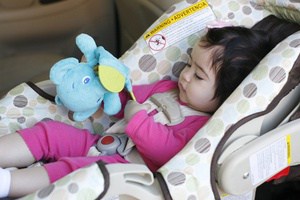
But you have to have the attitude that using the car seat is an unbreakable rule. You hope you won’t ever get in an accident. But if the unthinkable happens, using a car seat properly each and every time you drive is the best way to prevent injury to your child.
Buckling in Better
If your child cries or complains when being buckled in or when riding, first of all, you should make sure nothing’s pinching or rubbing their skin. Is the harness digging into the side of their neck? What about the crotch buckle? You can shield your baby’s skin by pulling clothes up or down to cover sensitive spots.
Children love repetition, so you may want to sing a special song when buckling, or softly and calmly reassure them that you’re almost done with this part, and when you’ve got it finished, everyone can relax and enjoy the ride.
Distress While Driving
If your child cries while you’re driving, try singing, playing a song your child seems to like, or play a game, if your child’s old enough to understand. Just talking to your child conversationally about where you’re going, the sights on the road, or what you’re going to do when you get to your destination can be very soothing.
Many kids like funny noises. Try asking what noise a snake or a dog makes, or demonstrating some animal sounds. You’ll be surprised how early your child will be able to imitate the sounds you make.
You can also bring a soft toy for your child, something that won’t be a projectile if you get in any kind of collision. If you have a favorite toy that goes everywhere, or a special toy that’s just for the car, that can be particularly helpful.
If all else fails, you can turn up the radio and let your child cry, secure in the knowledge that it’s not hurting them, and you’re doing your best to keep them safe.
Summing It All Up
As you can see, picking out the right car seat, installing it, and using it the right way every time is no easy feat. But parents manage it every day, and you can too. Now that you’ve read this guide, you can move confidently into this next stage of your child’s life, sure that you know how to keep them safe, and are doing the very best you can for your child and your family.

